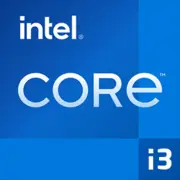Intel Core i3-2130

Intel Core i3-2130: Review and Recommendations for Budget Builds in 2025
Is the Sandy Bridge architecture still worth considering years later?
1. Key Specifications: An Outdated but Resilient Platform
The Intel Core i3-2130, released in 2011, is part of the second generation of Intel Core processors (codename Sandy Bridge). Despite its age, it is still found in budget PCs and office systems.
- Architecture and Process: 32 nm, 2 cores, 4 threads thanks to Hyper-Threading. Base frequency — 3.4 GHz (no turbo boost).
- Performance: In the Geekbench 6 (2025) benchmark, it scores 505 points in single-core and 976 in multi-core mode. For comparison, the modern budget Intel Celeron G7400 (2023) scores ~1200/2400 points.
- Key Features: Integrated Intel HD Graphics 2000 (supports DirectX 10.1), VT-x virtualization technology, AES-NI for encryption.
Practical Example: In 2025, this CPU can serve as the foundation for a terminal in a café — it will handle a browser and simple applications, but won’t manage rendering or modern gaming.
2. Compatible Motherboards: Searching the Secondary Market
The processor socket is LGA1155. Suitable chipsets include:
- H61, B65, H67, P67, Z68.
- Features:
- H61 — basic model without overclocking support and limited SSD support via SATA III (only 2 ports).
- Z68 — top-tier chipset with overclocking capabilities (but i3-2130 is locked for overclocking).
Tip: New motherboards haven’t been produced since 2013. On the secondary market (eBay, Avito), prices range from $20–40. Check the condition of capacitors and connectors!
3. Memory Support: Only DDR3
- Memory Type: DDR3-1066/1333 MHz.
- Maximum: 32 GB (theoretically), but most motherboards support 16 GB in practice.
- Nuances: Low frequency and high latency make memory a bottleneck in gaming and heavy tasks.
Example: When building a PC with the i3-2130, it's better to use two DDR3-1333 modules (8 GB × 2) in dual-channel mode — this will yield a +15% performance increase for the integrated graphics.
4. Power Supply Recommendations
- CPU TDP: 65 W.
- Advice:
- For a system without a discrete graphics card, a power supply of 300–400 W is sufficient (for example, be quiet! System Power 10 400W — $45).
- If adding a GPU (like the GTX 1650), choose a power supply of 450–500 W (Corsair CX450 — $55).
Important: Cheap power supplies (like $20 models) may operate unstably under peak loads.
5. Pros and Cons
Pros:
- Price: A used processor costs $10–15, while a new one (rare) is around $30.
- Energy efficiency: Consumes less than modern alternatives.
- Reliability: Sandy Bridge is known for its long lifespan.
Cons:
- Outdated architecture: No AVX2, PCIe 3.0, USB 3.0 support (depends on the motherboard).
- Weak multi-threading potential: 4 threads vs. 8+ in modern budget CPUs.
6. Use Case Scenarios
- Office Tasks: Word, Excel, browsing with 10+ tabs — handles without issues.
- Multimedia: Plays Full HD video (4K via YouTube lags), music, light editing in Shotcut.
- Gaming: Only older titles (CS:GO on low settings — ~40–50 FPS) or indie games (Stardew Valley, Hollow Knight).
Real Case: A user installed the i3-2130 in an HTPC for streaming Netflix via HDMI. Problems arose when attempting to decode AV1 — the format is not supported.
7. Comparison with Competitors
- AMD Phenom II X4 965 (2010): 4 cores without Hyper-Threading. In 2025, it lags in single-core performance (~420 in Geekbench 6), but excels in multi-threaded tasks.
- Intel Celeron G5920 (2020): 2 cores, 2 threads, but higher IPC and DDR4 support. Better for gaming (+20% to FPS), but more expensive ($60 new).
Conclusion: The i3-2130 remains relevant only in ultra-budget builds ($100–150 for the entire system).
8. Practical Assembly Tips
- SSD is Essential: Even a SATA SSD (Kingston A400 240GB — $25) will speed up system boot times by 3–4 times.
- Graphics Card: Add models without additional power requirements (GTX 1050 Ti, RX 560) — they won't overload the PSU.
- Cooling: The stock cooler is adequate, but replace the thermal paste (Arctic MX-4 — $5).
Warning: Don't invest in upgrading the LGA1155 platform — it's better to save money for a transition to LGA1700 or AM5.
9. Final Conclusion: Who Is the i3-2130 Suitable for in 2025?
This processor is suitable for:
- Enthusiasts building retro computers for Windows 7 or older games.
- Budget office PCs where minimal cost is crucial.
- Backup systems (like a home file server).
Why consider alternatives? Modern processors (Intel 12th generation, AMD Ryzen 3) offer 3–5 times higher performance for $100–150. But if your budget is limited to $50, the i3-2130 can still serve!
This article is relevant as of April 2025. Prices are indicated for new devices where available.
Basic
CPU Specifications
Memory Specifications
GPU Specifications
Miscellaneous
Benchmarks
Compared to Other CPU
Share in social media
Or Link To Us
<a href="https://cputronic.com/index.php/cpu/intel-core-i3-2130" target="_blank">Intel Core i3-2130</a>